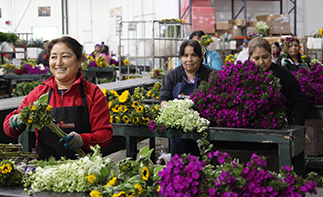|
Issue № 250
Oh, If Only It Was Just Like In The Movies!
~
Q and A
- with -
Dos Gringos
Q: If only what was just like the movies?
A: Many things but especially the weather.
Q: Why the weather?
A: In the movie “Groundhog Day”, starring Bill Murray as the television weather man, every day was exactly the same – even the weather.
Q: What is your point?
A: Just that it would be marvelous to know that we had the same weather every single day.
Then, we would not need the equivalent of a crystal ball to predict what happens with our outdoor crops.
Q: Are you nuts? Don’t you grow in Southern California and Mexico? Aren’t you Californian’s the ones who brag about barbecuing
your Christmas turkey wearing shorts and having a year-round flip-flop tan?
A: Yes we do and we are very grateful for the climate however that does not mean every day is flawless.
Q: Seriously?
A: Yes, indeed. San Diego County and Baja, Mexico have 4, very distinct climate zones. They are coastal, inland coastal, mountain, desert,
AND there are a numerous micro-climates within each of these zones. Therefore temperatures and precipitation can vary greatly.
And, that is not even allowing for what “Mother Nature” can do to if she sets her mind to wreak havoc.
Q: What happens then?
A: We are very lucky that our havoc is mainly in the form of lower night time temperatures or warmer than usual day time temperatures this time of year.
Q: How does that affect your crops?
A: The biggest effect is erratic harvest numbers. Since we diversify our growing regions to hedge against these issues,
the biggest issue is timing and cut stage.
Q: How so?
A: We like to cut our Sunflowers at what we call “Stage 2” where the heads are fairly closed and lots of green is visible (See pictures below).
If Mother Nature steps in with too much or too little rain/sunshine, or colder than normal night time temps, our crops can be impacted.
With too much sun, the Sunflowers might ripen too quickly, forcing us to harvest them earlier than planned.
Consequently, we monitor the weather and our harvests very, very precisely.
Q: That makes sense. Anything we should know about this years fall crop?
A: Of course, numbers are tracking well and these next two weeks are when we transition from our Late Spring-Early Fall growing
regions to our Late Fall-Early Spring growing regions. So far, all this means is that cut stages will be closer to a “Stage 1” and inventory will be a little more “just in time” than we would like it to be. The more “Groundhog Day” kind of weather we have the better.
Q: Got it. Can you tell us more about your Sunflower “Stages?”
A: I can do better than that. Here is our education sheet which explains it all…….

Sunflower Stages
Stage 1 
Cut at this stage in the field to decrease petal damage. This is the first stage of the Sunflower, which we call “Tight”.
When received at this cut stage the most important action is to re-cut the sunflower and put the flower in a vase/bucket to has at least 5 inches of fresh water.
Takes approx. 2-3 days to go from Stage 1 to Stage 2
Stage 2 
This is the second stage of the Sunflower cut which we refer to as the “Opening Stage”. Be prepared to have stems within the bunch open inconsistently (as seen).
When received at this cut stage the most important action is to make sure the vase/bucket has fresh water
(must be changed every 2 days) and is maintained at a consistent temperature (between 55-70 degrees).
Takes approx. 2-3 days to go from Stage 2 to Stage 3
Stage 3 
This is an ideal stage for Sunflowers as they should have a more uniform cup-stage appearance.
This third stage is known as the “Blossoming Stage” Make sure water has been replaced from initial uptake (stage 2) and re-cut to accelerate opening stage.
Takes approx. 5-7 days to go from Stage 3 to Stage 4
Stage 4/5  
This is the fourth and final stage of the Sunflower and is subsequently names the “Open Stage”.
Once it reaches the full blown stage, petals will begin to fall off.
When sunflowers reach this stage they should be kept in low to moderate temperature (55-70 degrees), so they last longer and age less quickly.
Takes approx. 2-3 days before petals start falling off.
Handling Guide Store Level
Re-cut and change sunflower water every two days (to ensure freshness).
Keep water between 55-70 degree temperature intervals to see slow stage changes. Accelerate stage changes and decrease life span of sunflowers in 70+ degree temperature.
Ideal to sell sunflowers at stage 2-3 so customers see sunflower progression.Cut at this stage in the field to decrease petal damage.
This is the first stage of the Sunflower, which we call “Tight”.When received at this cut stage the most important action is to re-cut the sunflower and
put the flower in a vase/bucket to has at least 5 inches of fresh water.Takes approx. 2-3 days to go from Stage 1 to Stage 2

|



